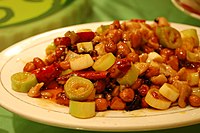
Back مطبخ سيشوان Arabic Gastronomía de Sichuan Spanish آشپزی سیچوآن Persian Cuisine sichuanaise French Hidangan Sichuan ID Cucina del Sichuan Italian 四川料理 Japanese სიჩუანის სამზარეულო Georgian 쓰촨 요리 Korean Gastronomia Sichuanensis Latin
| Sichuan cuisine | |||||||
|---|---|---|---|---|---|---|---|
 | |||||||
| Chinese | 四川菜 | ||||||
| |||||||
| Chuan cuisine | |||||||
| Chinese | 川菜 | ||||||
| |||||||
| Part of a series on |
| Chinese cuisine |
|---|
 |

Sichuan cuisine or Sichuanese cuisine, alternatively romanized as Szechwan cuisine or Szechuan cuisine (Chinese: ⓘ, Standard Mandarin pronunciation: [sɨ̂.ʈʂʰwán] ⓘ)[1] is a style of Chinese cuisine originating from Sichuan province and the neighboring Chongqing municipality. Chongqing was formerly a part of Sichuan until 1997; thus, there is a great deal of cultural overlap between the two administrative divisions. There are many regional, local variations of Sichuanese cuisine within Sichuan and Chongqing.[2]
It is renowned for fiery and bold tastes, particularly the pungency and spiciness resulting from liberal use of garlic and chilis, as well as the unique flavors of Sichuan (Szechuan) pepper. Some examples are Kung Pao chicken and Yuxiang shredded pork. Four substyles of Sichuan cuisine include Chongqing, Chengdu, Zigong (known for a genre of dishes called Yanbangcai), and Buddhist vegetarian style.[3]
UNESCO declared Chengdu, the capital of Sichuan Province, a city of gastronomy in 2011.[4]
- ^ "How can Sichuan cuisine break through three major problems if it wants to enter the international perspective?". November 18, 2023.
- ^ "Sichuan Cuisine History".
- ^ Dunlop (2003), p. 23-24.
- ^ UNESCO (2011). "Chengdu: UNESCO City of Gastronomy". UNESCO. Retrieved May 26, 2011.